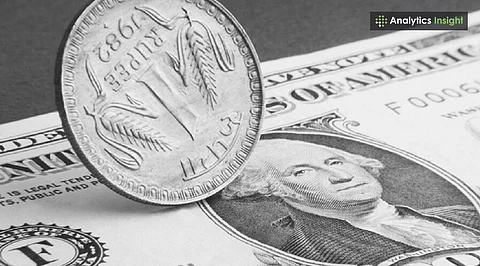

Indian rupee is regaining its position against the US dollar. On Wednesday, Indian rupee strengthened by 0.2% and reached Rs. 87.73, which further rose to Rs. 87.74. Following its record closing low on Tuesday at Rs. 87.80, the market was waiting for the Reserve Bank of India’s interest rate decision later in the day, which marked a decent change to the rate driving the rise.
On August 5, the rupee suffered its third consecutive low at Rs. 87.80, which was down 14 paisa from Monday’s Rs. 87.66. Midday, it further fell to Rs. 87.885, reaching almost closer to its all-time low closing price of Rs. 87.95 from February.
Reports claimed that the Indian rupee's fall is driven by US President Donald Trump's threat to raise tariffs further on Indian products over Russian oil purchases. One of the most discussed announcements from last week was that there would be a 25% duty on all Indian imports and penalties for buying Russian oil.
He even mentioned that tariffs on semiconductors and pharmaceuticals will also be declared sometime soon. Notably, reports indicate it may see a massive leap of around 250% within 12 to 18 months. These increased tariff rates are what drove the fall of Indian rupee.
Entering Wednesday, the rupee clawed back. As quoted, it is standing at Rs. 87.74 against the U.S. dollar at 09:42 am IST, a little up from 87.80 on Tuesday. This modest revival was initiated after the RBI intervention via state-run banks curbed the slide. According to a currency trader at a private bank, “At these levels, the rupee will move on its momentum, and today's decision adds another layer.”
Investors are closely eyeing RBI’s Monetary Policy Committee meeting. However, most economists expect there won’t be any change in the repo rate at 5.50%, even though major banks such as SBI and ICICI are pushing for a cut to spur growth.
At this point, marketers are experiencing mixed indications: on one hand, the US tariff threats and capital outflow continue to threaten the currency; on the other, predictions of stable domestic inflation and softened dollar sentiment offer some support.
Also Read: Trump's 25% Tariff News: Why India's Stock Market is not Much Concerned
The 0.2% bounce of the rupee and return to Rs. 87.73 is not a very strong comeback. Instead, it's a fragile revival likely to be fueled by central bank intervention and not by any sustainable sentiment shift. Trade tensions with the US remain unchanged and are the most problematic aspect.
Going forward, the rate call by the RBI can become a game changer. A no-change decision will reinforce stability. However, a non-aggressive policy may unsettle traders further, specifically at a time when global dollar trends and U.S. tariff developments remain highly unpredictable. Until clarity comes on both sides, Indian rupee will remain under pressure.
